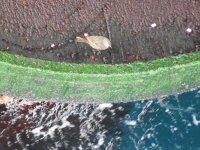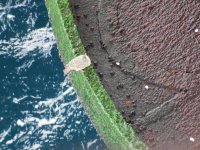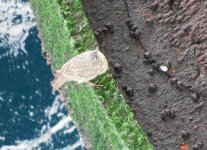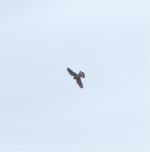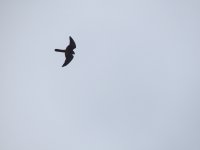Another Good Day.
Currently, I am working on nightshift, however, as I start at 17:30 hrs and finish at 05:30 hrs, I still get quite a few hours of daylight before dusk and after dawn.
In addition to these onshift daylight hours, I also popped up to the helideck area for a quick check at about 16:00 hrs. There is a small access mezz here that allows me to look over the helideck and also over the flat roof of the upper accommodation. I have found this to be a good area for birds, as it is high up and fairly open, but with a bit of available cover in the form of ducting and support structure. It was in this area that I spotted the sleeping Blackcap a few days ago. Today, I found a wide awake Blackcap, and although it was also a female, I don't think it was the same bird.
Having checked out the area, I started to head down the access stairs when my eye was drawn by a movement. I thought it would be the Blackcap reappearing from the cover it had dived into, but instead, a busy little Willow Warbler appeared. It fussed around then flew off in an easterly direction.
An hour or so later, I was descending the south side of the platform. I had an eye open for Swallows and also for Sparrowhawk. When heading up the same route at about 06:00 hrs this morning, I'd seen both flying about. I'd known that a couple of Swallow had roosted overnight, but hadn't realised that the Sparrowhawk spotted a day or two ago, had hung about.
Now heading down the stairs, I suddenly saw a hawk in the air, but this was no Sparrowhawk this time. Instead, I found myself looking down at a soaring Kestrel. Another first for the year. Not an unusual visitor however. Later in the evening, while doing my rounds, I found the bird again. This time perched on a scaffold pole. I returned with a camera, but it was gone. Then suddenly it swooped into sight. I froze as it dived towards me and landed about 8ft away on a steel beam. I tried to slowly raise the camera, but the slight movement gave my presence away and it was off again.
I've seen the Kestrel a couple more times this evening, and also found a Chiffchaff and another Willow Warbler. I may also have seen the Sparrowhawk again at about 21:30 hrs in the semi darkness. It was certainly a hawk, and I don't think it was the Kestrel. It was at distance and heading away from the platform in an easterly direction. Whichever hawk it was, hopefully it will soon be flying in Norwegian airspace.
The 2017 List Updated
1. Herring Gull
2. Great Black-Backed Gull
3. Glaucous Gull
4. Iceland Gull
5. Fulmar
6. Kittiwake
7. Long-Tailed Duck
8. Common Scoter
9. Gannet
10. Guillemot
11. Greylag Goose
12. Collared Dove
13. Goldcrest
14. Woodpigeon.
15. Peregrine
16. Sparrowhawk
17. Blackbird
18. Common Gull
19. Pied Wagtail*
20. Yellowhammer*
21. Goldfinch
22. Siskin
23. Robin
24. Rock Pipit
25. Ruff (d)*
26. Golden Plover
27. Swallow
28. House Martin*
29. Chiffchaff
30. Blackcap
31. Willow Warbler
32. Kestrel




